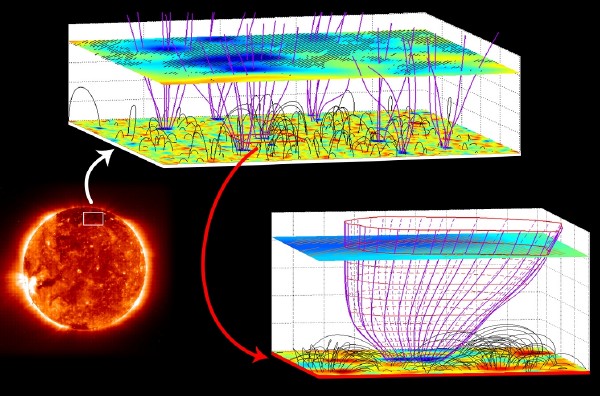Solar Wind Origin in Coronal Funnels
Click on image for larger version |
The magenta curves illustrate open magnetic field lines, dark grey arches show closed ones. The lower plane shows the magnetic field vertical component, from MDI (blue to red). The upper plane shows Ne VIII Doppler shift from SUMER (hatched regions have large outflows) with the inclination of the magnetic field (blue to red), extrapolated from the MDI measurements. |
The nature and origin of the solar wind is one of the main problems which SOHO was designed to solve. Now, a Chinese-German team of scientists has made yet another step in the understanding of the fast solar wind. Using complex analysis of both MDI and SUMER data, the team places the source region somewhere between 5,000 and 20,000 kilometers above the surface, in magnetic funnels whose existence can be inferred by extrapolation from the magnetic fields at the surface.
For a long time, the fast solar wind has been known to originate from so-called "coronal holes", with open magnetic field lines, as opposed to the slow solar wind that comes from regions where just about all field lines are closed, looping up from the surface and then back down again. But the site of the origin has never before been pinned down in 3 dimensions based on observations.
Previously it was believed that the fast solar wind originates in the layer where hydrogen becomes ionised, less than 2,000 km above the photosphere. These observations, however, show that bulk outflow has not yet occurred at a height of 5,000 km, but it is present at 20,000 km. The scientists propose that the solar wind plasma is supplied by closed magnetic loops that are swept by convection to funnel regions where they undergo reconnection with existing open field lines. Thereby plasma previously confined within closed loops is released and may be accelerated to form the solar wind.
The findings appeared in a research article called "Solar Wind Origin in Coronal Funnels" in Science magazine on 22 April 2005.
Related links
- Solar Wind Origin in Coronal Funnels
(ESA Science & Technology)
- Science magazine (22 April 2005, Volume 308 No 5721)
Contact:
- Eckart Marsch
Max Planck Institute for Solar System Research, Katlenburg-Lindau, Germany
Phone: (+49 5556) 979 - 423
Fax: (+49 5556) 979 - 240
Instruments: SUMER (Solar Ultraviolet Measurements of Emitted Radiation), MDI (Michelson Doppler Imager), EIT (Extreme ultraviolet Imaging Telescope).



